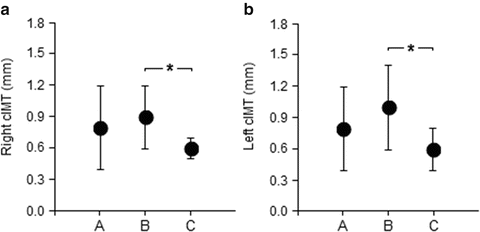Moderate OSA Group A (n = 15)
Severe OSA Group B (n = 15)
Control Group C (n = 20)
p <0.05
Age (years)
59.6 ± 6.5
54.5 ± 8.9
47.0 ± 12.4
C vs. A
BMI (kg/m2)
30.7 ± 2.5
32.2 ± 5.5
27.0 ± 3.5
B vs. C
SBP (mmHg)
126.0 ± 15.8
149.0 ± 15.2
130.0 ± 8.6
B vs. A, B vs. C
DBP (mmHg)
75.3 ± 9.9
83.3 ± 9.8
77.2 ± 7.3
B vs. A
Right cIMT (mm)
0.8 ± 0.4
0.9 ± 0.3
0.6 ± 0.1
B vs. C
Left cIMT (mm)
0.8 ± 0.4
1.0 ± 0.4
0.6 ± 0.2
B vs. C
In the present study, severe sleep-disordered breathing, as reflected by AHI >30 of nocturnal episodes per hour, clearly corresponded to a higher value of cIMT in both right and left common carotid arteries (Fig. 1a and b, respectively). The thickness of carotid intima-media layer was significantly greater in the hypertensive patients from the group of severe OSA compared with that in the control hypertensive subjects; 0.9 ± 0.3 vs. 0.6 ± 0.1 mm in the right and 1.0 ± 0.4 vs. 0.6 ± 0.2 mm in the left common carotid artery, respectively. This thickness in severe OSA patients also was greater than that in moderate OSA patients, although the differences here did not reach statistical significance.


Fig. 1
Estimation of carotid intima-media thickness (cIMT) in the right (Panel A) and left (Panel B) common carotid artery. Group A – moderate sleep apnea; Group B – severe sleep apnea; Group C – no sleep apnea. The subjects of all three groups were originally hypertensive. *p <0.05
4 Discussion
4.1 OSA and Obesity
There is a clinical interest in the association between obesity and OSA. It is known that excessive body weight is the most significant predictor of sleep apnea, and hence, the prevalence of OSA is undoubtedly rising due to the pandemic of obesity. Large epidemiological studies reported a close association between OSA prevalence and BMI (Peppard et al. 2000; Young et al. 1993). The Sleep Heart Health Study showed that OSA individuals with greater than 10 kg weight gain over the follow-up period had a 2.5-fold risk (women) to 5-fold risk (men) of increasing their AHI over 15 episodes per hour (Young et al. 1993). It has also been estimated that the risk of having moderate-to-severe sleep apnea over a 4-year period increases sixfold among patients gaining 10 % excess weight (Peppard et al. 2000). Likewise, data collected in the present study showed a clear tendency for increasing body weight across the groups of individuals investigated, from controls to moderate OSA, and to severe OSA, although statistical significance of changes in body weight was not achieved due likely to small numbers of individuals in each group.
4.2 OSA and Hypertension
In recent years a considerable progress has been made regarding the association between sleep disorders and cardiovascular diseases. As far as hypertension is concerned, the driving force for the understanding of the cause were some epidemiological data. In the studies involving hypertensive subjects, the prevalence of OSA was 22–62 %, with levels as high as 71 % among drug resistant hypertensive subjects, and the other way around, approximately 50 % of OSA patients were hypertensive (Lavie et al. 1984, 2000). There is strong epidemiological evidence from several large cross-sectional studies that untreated OSA is a risk factor for arterial hypertension, independently of confounders such as obesity (McNicholas et al. 2007). The results from prospective studies of middle-aged adults are different. Some authors conclude that OSA is associated with a two- to three-fold risk of developing hypertension over a 4 to 8-year period, whereas others do not report a positive association between OSA and hypertension (O’Connor et al. 2009; Peppard et al. 2000). Furthermore, the relationship between OSA and hypertension has not been confirmed in elderly subjects. The strength of this association decreases with age due likely to the accumulating confounding risk factors (Bixler et al. 2000).
In the present study we attempted to analyze the relationship between the severity of OSA and blood pressure values in patients with recently diagnosed OSA and coexisting essential hypertension without other co-morbidities. We carefully selected patients with chronic hypertension lasting for a similar time from diagnosis and with similar antihypertensive medications taken. The results are in line with those of other prospective studies which point to blood pressure elevation with increasing AHI (O’Connor et al. 2009; Young et al. 1993). We confirmed previous findings that patients with severe OSA had significantly higher systolic and diastolic blood pressure values compared with moderate OSA (Bixler et al. 2000; Lavie et al. 2000). However, opposite data can also be found in the literature. Baguet et al. (2009) failed to show any difference in blood pressure stratified by the severity of OSA in a population of subjects with newly diagnosed OSA.
Stay updated, free articles. Join our Telegram channel

Full access? Get Clinical Tree


